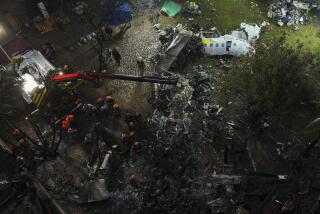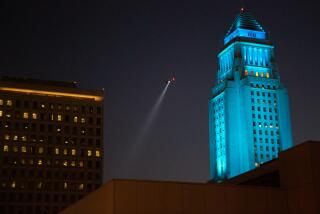Above Congested Sao Paulo, the Commute Is Heavenly
- Share via
SAO PAULO, Brazil — Seen from a helicopter, the urban monster turns tame and beautiful.
The hemisphere’s second-biggest city unfolds like a tapestry beneath the helicopter piloted by Marcos de Almeida Buozi. A night of rain has made it all gleam. Pale forests of skyscrapers. Squat gray automotive factories. Orange and brown shantytowns splattered across hillsides.
To veteran pilots like Buozi, the landscape blooms with opportunity. In just six years, Sao Paulo has acquired more than 470 helicopters, the world’s third-biggest urban fleet after New York and Tokyo. The boom has doubled the number of helipads atop mansions, hotels, banks, shopping malls and government buildings.
As Buozi glides across the Wednesday morning cityscape, his French EC 120 helicopter performs a careful minuet with other aircraft. He greets pilots who are depositing executives on an office tower, monitoring satellite-equipped armored cars and surveying expressways choked with rush-hour traffic.
“This is nothing,” Buozi says above the whine of the rotors. “On Fridays it takes hours to drive anywhere. Everyone who can escape the city escapes. To the country, the beach. The roads are packed. And the sky is full of helicopters.”
Sao Paulo’s cultural sophistication, immigrant-driven energy and industrial brawn combine aspects of Los Angeles, New York and Detroit. Its uniquely Brazilian charm survives the strains of city life. But the emergence of helicopters as the preferred transport of the rich has become a symbol of urban dysfunction. Seen from the street, the helicopter boom becomes a darker story, a tale of two Sao Paulos.
Like other Latin American mega-cities, Sao Paulo has sunk into a science fiction-like murk of traffic, pollution and crime. During the past 10 years, the rich and middle class have sought the insulation and isolation of suburbs, shopping malls and fortified private communities. Having failed to plan for or combat the crisis, the elite avoid it by taking to the air.
Helicopters are fast and glamorous. Helicopters ward off kidnappers and carjackers. Helicopters have become ubiquitous because Brazil puts few restrictions on their movements. At times, the horizon near enclaves of privilege resembles a mix of “Blade Runner” and “Apocalypse Now.”
“It must be nice up there,” says Alexandre Wyenne Da Silva, 19, a bicycle deliveryman in Villa Olimpia, the newest business center to have sprouted in the congested central city. “Down here, things are very complicated. The traffic in Sao Paulo is madness.”
Da Silva makes deliveries for a sandwich shop. Clad in a baseball cap and brown vest, the jaunty young man maneuvers a clunky red bicycle equipped with baskets fore and aft. He rolls past sweaty pushcart vendors hawking melon slices and merchants in scruffy vans selling fried food and soft drinks.
Da Silva leaves the bicycle at work at the end of the day. He spends more than an hour commuting to and from Villa Olimpia. His bus slogs through streets that choke on exhaust fumes in the heat and flood furiously when it rains, exposing stalled drivers to marauding criminals. Streets where graffiti crawls impossibly up the walls of gloomy 20-story buildings, conjuring images of taggers hanging by their ankles from windows or rappelling from rooftops.
Although helicopter commuters are as alien to Da Silva as Martians or pterodactyls, he considers himself lucky. He knows quite a few people who can’t even afford the bus.
“At least I don’t have to walk to work,” the deliveryman says. “It could be worse.”
In fact, an increasing number of working people here get around on foot to save money. Those lengthy hikes are part of the “unjust and bizarre” socioeconomic hierarchy of transport, according to Jorge Wilhelm, an urban affairs expert and former planner for the state of Sao Paulo.
Sao Paulo is the world’s fourth-most-populous city, with almost 18 million residents. They make 30 million trips a day, split roughly in thirds between mass transit, cars and walking. In comparison, more than half the daily trips in cities such as London and Paris use far-flung subway and bus lines. Even Mexico City, whose size and woes rival those of Sao Paulo, has a much larger subway network, Wilhelm says.
The dire lack of public transportation here contributes to commutes that last as long as three hours. Commuters generally do not cover vast distances like Southern Californians, who might drive from homes in the Antelope Valley to jobs in El Segundo. Instead, Paulistanos must contend with agonizingly slow traffic: Buses here often travel at less than 10 mph, according to Wilhelm.
“They might as well be walking,” he says of commuters.
The root problem: Brazilians are mobile, individualistic and cherish their cars, much like Californians. Long-range transportation planning is not popular here.
“It’s not politically attractive, and we have other important items on the political agenda that you have to solve, like sanitation, sewage, housing,” Wilhelm says. “Planning is not popular. It is seen as an imposition that hinders my freedom of growing and getting rich.”
Unlike the United States, where prosperity has produced an urban renaissance, Brazil’s biggest cities are getting worse rather than better. The number of helicopter commuters here remains statistically insignificant, but it is a disturbing symptom, Wilhelm says.
“This is just another symbol that we are abandoning public space,” he says. “A space abandoned to poor people and bandits who are avoided by the rich and the middle class. The social fragmentation has increased the state of chaos. This organization of society could get worse, and we shall go through life as some of the worst science fiction films. . . . This is not only a problem of Sao Paulo but many cities.”
The helicopter boom results from opportunities as well. Pent-up demand mushroomed after 1995, as the nation’s economy stabilized and modernized. Brazil already had a strong tradition of aviation and aircraft manufacturing.
“There have been very few helicopter accidents,” says Flavio Pires of Lider Taxi Aero, a thriving helicopter leasing and taxi service here. “Brazil has a very developed aeronautical culture.”
Helicopter pilots also have considerably fewer restrictions than in the United States when it comes to flying over cities. Lider and companies like it have found numerous niches in a financial capital renowned for a hard-charging entrepreneurial spirit.
More banks and corporations are willing to spend $1.5 million for a helicopter, plus maintenance and pilot wages, to maximize the efficiency of their executives. Tycoons fearful of highly organized kidnappers shell out more than $6 million for top-of-the-line models such as 12-passenger Dauphins, Sikorskys or Bells. Politicians, police and hospitals also see the aircraft as a necessity.
Helicopters provide status, safety and peace of mind, says Ronald Koraicho, an ardent pilot. In addition to his Lebanese immigrant family’s furniture business, he founded a small taxi service that charges $300 to $800 an hour.
“There’s the aesthetic aspect,” he says. “Flying is very beautiful.”
The airborne lifestyle was chronicled in a magazine article about the helicopter traffic jam at the birthday party of a construction magnate at Angra dos Reis, an island resort where the elites of Sao Paulo and Rio de Janeiro keep vacation homes.
So many guests arrived by air that the rotor wind blew away tablecloths and ornate place settings, according to the article in Veja magazine two years ago.
“Every guest who arrived, instead of bringing happiness, caused sadness,” lamented an interior decorator who organized the party. That provoked the magazine writer to comment: “Isn’t life tough for the rich?”
In fact, this brash new culture creates futuristic friction as noise plagues upscale neighborhoods and walled condominium complexes. Pires describes how an elderly woman waged a private war against a neighboring helipad, snapping photos and firing off complaints until she succeeded in limiting its use to three landings a day.
Brazil’s helicopter market is one of the world’s strongest, Pires says. Sao Paulo and nearby Rio de Janeiro accounted for 80% of sales in the nation last year. Until the cities untangle their streets, the horizon will be filled with helicopters.
More to Read
Sign up for Essential California
The most important California stories and recommendations in your inbox every morning.
You may occasionally receive promotional content from the Los Angeles Times.













